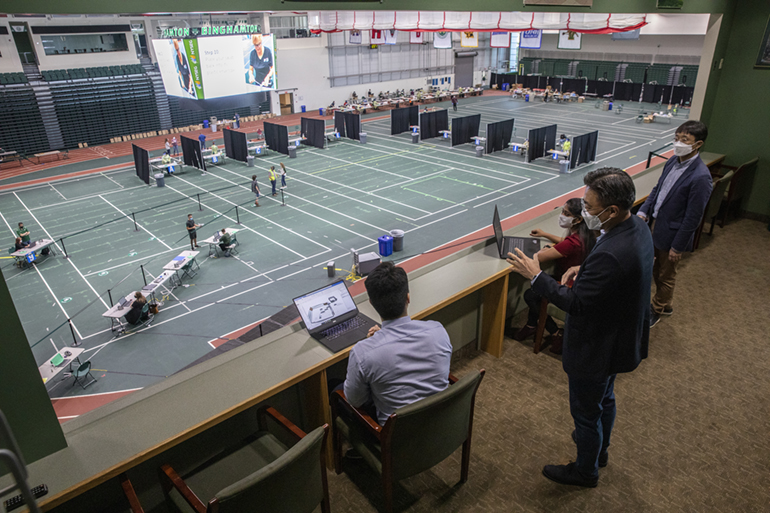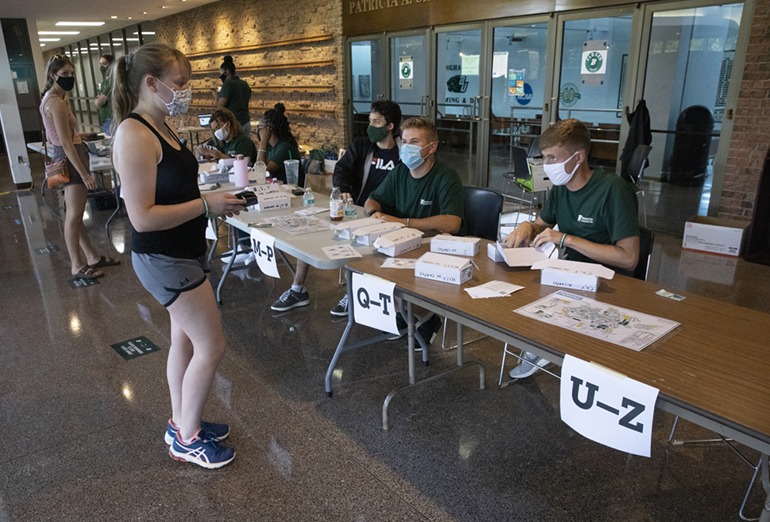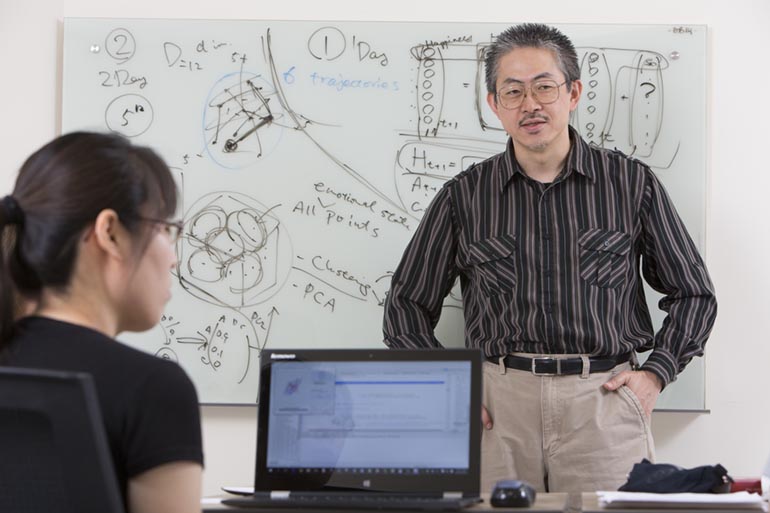Restarting Binghamton: Systems science and industrial engineering help to guide plan’s safety, efficiency
Watson College professors offer input for testing center, campus density and more

When Binghamton University’s leadership team needed to develop strategies for a safer campus in the wake of the COVID-19 pandemic, it turned to systems science and industrial engineering professors who consider similar scenarios on a daily basis.
And as students return to Binghamton over the next week, that input from faculty members and their students from the Thomas J. Watson College of Engineering and Applied Science continues to improve the move-in process to make it as fast and efficient as possible.
Tweaking the move-in process
During previous fall semesters, first-year students would arrive on a designated Sunday and returning students would come back on Monday.
This year, the move-in process is over seven days, from Aug. 19-25, with appointments assigned for each student to accommodate coronavirus testing and maintain social distancing. Students who have shown no COVID-19 symptoms arrive at the Events Center at their designated times and get tested, then wait outside with their families for a text notifying them of the results in 20 to 30 minutes.
Students who receive a negative result will check in with Residential Life in the West Gym, adjacent to the Events Center, be given card access to their residence halls, and proceed to the halls to move in their belongings.
About 100 students per hour have been processed in the first few days of move-in, but that number will rise to about 125 per hour on Sunday and Monday.
Earlier this week, President Harvey Stenger asked Professor Sangwon Yoon and Assistant Professor Soongeol Kwon from Watson College’s Department of Systems Science and Industrial Engineering to go to the Events Center with PhD students Ingyu Lee and Arushi Agarwal to monitor the process, create a model and suggest improvements. They also gave some ideas for the West Gym so the Res Life process also would be quicker.
As part of their work with the Watson Institute for Systems Excellence (WISE), Yoon and Kwon had observed previous move-in days and run simulations to suggest ideas for better efficiency.
“During past move-in days, the parking lots were crowded and the traffic was heavier, especially around 3 or 4 p.m. when all the faculty and staff were leaving but students were still coming in,” Yoon said. “We had to identify some of the choke points.
“This year, the difference is testing. We have fewer students coming in — only 6,000 on campus — so the parking lots and traffic are not an issue. This year, it is all about the flow inside the testing center with students checking in and moving to their residence halls. Because many faculty and staff are still not reporting to campus, parking and traffic are not as much of an issue.”
Sometimes the answers to expedite the process are simple but effective, such as shortening the time spent greeting students, reconfiguring how volunteers are utilized, altering shift changeover times, adding more check-in or testing stations, and establishing a maximum number for queues at different stations.
Because of how the tests are conducted — with samples needing to incubate for 15 minutes before results can be ascertained — there is a hard time limit to the entire process.
“If the timing is more than 30 minutes, we cannot use the sample – we need to recollect it,” Yoon said.
Earlier this summer, Yoon and Kwon ran simulation models for indoor and outdoor spaces such as classrooms, lecture halls, hallways and sidewalks to determine how social-distancing requirements would be applied to the everyday flow of students, faculty and staff. Highlights of their work were included in a recently released Restarting Binghamton video.
“We are systems engineers, and we are interested in how we can apply our knowledge to real-world problems,” Kwon said. “So this is good practice and allows us to contribute to the campus. I’m glad to be involved in this project.”
While working this week at the COVID-19 testing center, he added, “we can see in real time how our suggestions are implemented, and that’s a very exciting thing for us.”
Yoon said he has been pleased by the cooperation and help from everyone involved in the move-in process: “We are grateful to all faculty, staff and volunteers for their time, effort and dedication — including President Stenger, who is at Events Center every day to make sure everything goes well. We also appreciate all the patience from incoming students and their families. I feel that everyone is very cooperative. We’re glad to be part of this.”
A campus-wide perspective
While Yoon and Kwon studied Binghamton University from the ground level, fellow SSIE Professor Hiroki Sayama and PhD student Shun Cao looked at the Vestal campus from a bird’s-eye perspective.
Sayama — who is the director of the Center for Collective Dynamics of Complex Systems (CoCo) — collected data to simulate a typical day of activity. Choosing a random Tuesday last fall, he and Cao built a time-lapse model to identify “hot spots” when and where crowds of people would make proper social distancing more difficult.
“We took as much information as possible from the many different divisions of the University administration — everybody who has data on all kinds of information, like who went to which classes,” Sayama said.
“Names were removed, of course, but we got the data about the residence halls where they live and which courses they took — the locations and times for classes at the entire University. The behavior was very precise.”
The resulting model does not show the exact locations of everyone on campus — for instance, many students do more than leave their residence halls, go to class, eat a meal and then return to their rooms. But Sayama thinks that it’s a “reasonable” heuristic model that agrees with what students, faculty and staff have experienced: Foot-traffic volume is highest around lunchtime and centered around the University Union and the nearby library and lecture halls.
“Ideally, we should have flown some kind of drone on a Tuesday and record the entire campus from high above, but systems science allows you to reconstruct the same result,” he said. “This kind of model actually gives us more power, because now we can test hypothetical scenarios that never happened, such as density reduction. What if the campus population is reduced to 50%? The effective point, as we discovered, is actually less than half [at 40%].”
Not coincidentally, that 40% goal is built into the Restarting Binghamton plan that Stenger and other University leaders developed alongside public-health experts.
Sayama referred to using systems-science principles for a campus-wide simulation as “uncharted territory,” and something that could be done only because of the highly regimented environment of a university. A similar model for, say, Broome County as a whole would not be possible because data sets that large would be hard to obtain, due to privacy issues and the less predictable nature of everyday residents.
While a few other colleges and universities are creating their own campus models, Sayama said, “we created our model from scratch, because every single campus simulation model is unique to the specific situations they are in. We can’t get one software to feed the data into and create the model.
“All researchers need to learn a lot about local situations and domain-specific knowledge, like the location of food sources, transportation methods and how parking spaces are allocated on campus. Those details can change the model completely.”
Part of building the model required putting significant research hours into figuring out the variables. For instance Cao used Google Earth to hand-code the intersections of all campus paths by latitude and longitude.
Now that the work has been done, though, it can be utilized for situations beyond the current coronavirus response.
“Even for non-pandemic related tasks, this data set might be useful for campus planning purposes,” Sayama said. “After COVID is over, we may want to host an event on campus and we can use a similar model to simulate the congestion patterns of the students’ movement.”



